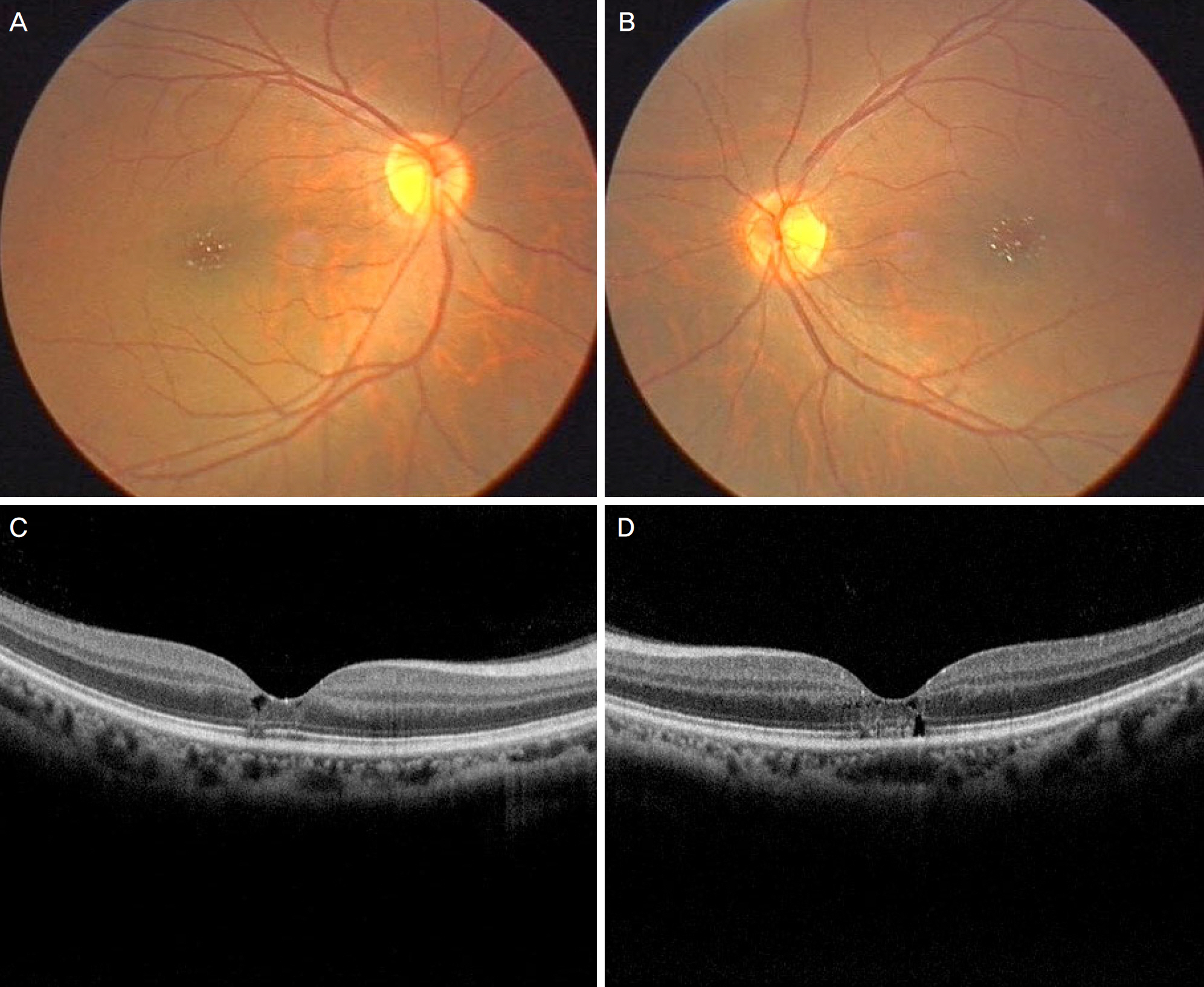J Korean Ophthalmol Soc.
2016 Oct;57(10):1656-1660. 10.3341/jkos.2016.57.10.1656.
To Report a Case of Tamoxifen-induced Retinopathy Diagnosed Using Spectral Domain Optical Coherence Tomography
- Affiliations
-
- 1Department of Ophthalmology, Myongji Hospital, Seonam University College of Medicine, Goyang, Korea. Kimdk89@empas.com
- KMID: 2355425
- DOI: http://doi.org/10.3341/jkos.2016.57.10.1656
Abstract
- PURPOSE
To report a case of tamoxifen-induced retinopathy diagnosed using spectral domain optical coherence tomography (SD-OCT).
CASE SUMMARY
A 44-year-old female presented with metamorphopsia in the left eye and binocular vision loss which started 5 months prior. She had no record of external trauma, diabetes or high blood pressure; however, she had been taking 21.9 g tamoxifen (20 mg/day) since October 2012 after a surgery of her left breast due to cancer. On the initial visit, fundus photography showed crystalline dot-like deposits in both parafoveae. Additionally, fluorescence angiography revealed a small leakage around the macular area. Optical coherence tomography (OCT) was obtained to differentiate from other diseases because fundus photography showed crystalline retinopathy. The OCT revealed a normal right eye but the left macula had a microcystic lesion. Based on the diagnosis of tamoxifen-induced retinopathy, the patient stopped taking tamoxifen. Three months after discontinuation of tamoxifen, fundus photography showed slightly decreased crystalline deposits in the parafoveal area and visual acuity of the right eye was slightly improved. However, SD-OCT showed a slightly aggravated disruption of the outer retina in both eyes.
CONCLUSIONS
Although retinopathy caused by treatment with tamoxifen occurs infrequently, to prevent complications and irreversible damage, patients who take tamoxifen for medical purposes need to undergo a regular ophthalmologic examination.
Keyword
MeSH Terms
Figure
Cited by 1 articles
-
Uveoretinal Adverse Effects Presented during Systemic Anticancer Chemotherapy: a 10-Year Single Center Experience
Ah Ran Cho, Young Hee Yoon, June-Gone Kim, Yoon Jeon Kim, Joo Yong Lee
J Korean Med Sci. 2018;33(7):. doi: 10.3346/jkms.2018.33.e55.
Reference
-
References
1. Paganini-Hill A, Clark LJ. Eye problems in breast cancer patients treated with tamoxifen. Breast Cancer Res Treat. 2000; 60:167–72.
Article2. Lazzaroni F, Scorolli L, Pizzoleo CF, et al. Tamoxifen retinopathy: does it really exist? Graefes Arch Clin Exp Ophthalmol. 1998; 236:669–73.
Article3. Kaiser-Kupfer MI, Lippman ME. Tamoxifen retinopathy. Cancer Treat Rep. 1978; 62:315–20.4. Nayfield SG, Gorin MB. Tamoxifen associated eye disease. A review. J Clin Oncol. 1996; 14:1018–26.5. Hahn DK, Park YH. A case of crystalline retinopathy. J Korean Ophthalmol soc. 1995; 36:142–6.6. Chang TS, Aylward W, Clarkson JG, Gass JD. Asymmetric can-thaxanthin retinopathy. Am J Ophthalmol. 1995; 119:801–2.
Article7. Bullock JD, Albert DM. Fleck retina. Appearance secondary to ox-alate crystals from methoxyflurane anesthesia. Arch Ophthalmol. 1975; 93:26–31.8. Chang T, Gonder JR, Ventresca MR. Low-dose tamoxifen retinopathy. Can J Ophthalmol. 1992; 27:148–9.9. Doshi RR, Fortun JA, Kim BT, et al. Pseudocystic foveal cavitation in tamoxifen retinopathy. Am J Ophthalmol. 2014; 157:1291–8.e3.
Article10. Jeng KW, Wheatley HM. Intravitreal triamcinolone acetonide treatment of tamoxifen maculopathy with associated cystoid abdominal edema. Retin Cases Brief Rep. 2015; 9:64–6.11. Srikantia N, Mukesh S, Krishnaswamy M. Crystalline maculopathy: a rare complication of tamoxifen therapy. J Cancer Res Ther. 2010; 6:313–5.12. Bourla DH, Gonzales CR, Mango CW, et al. Intravitreous vascular endothelial growth factor (VEGF) inhibitor therapy for tamoxifen induced macular edema. Semin Ophthalmol. 2007; 22:87–8.
Article13. Suhk HJ, Sohn JH, Yoon YH. Retinopathy and keratopathy associated with chronic tamoxifen medication. J Korean Ophthalmol soc. 2002; 43:2354–9.14. Cho HK, Ko SM. A case of crystalline retinopathy. J Korean Ophthalmol soc. 1997; 38:1628–31.15. Kim HD, Seo MS. Crystalline retinopathy without corneal dystrophy. J Korean Ophthalmol Soc. 2000; 41:1445–50.
- Full Text Links
- Actions
-
Cited
- CITED
-
- Close
- Share
- Similar articles
-
- Choroidal Thickness at the Outside of Fovea in Diabetic Retinopathy Using Spectral-Domain Optical Coherence Tomography
- A Case of Acute Bilateral Solar Retinopathy Diagnosed with Spectral Domain Optical Coherence Tomography
- Difference of GCIPL Thickness of Diabetes and Normal Eyes in Spectral Domain OCT
- Comparison of Spectral-Domain and Time-Domain Optical Coherence Tomography in Solar Retinopathy
- Comparison of Choroidal Thickness in Patients with Diabetes by Spectral-domain Optical Coherence Tomography



